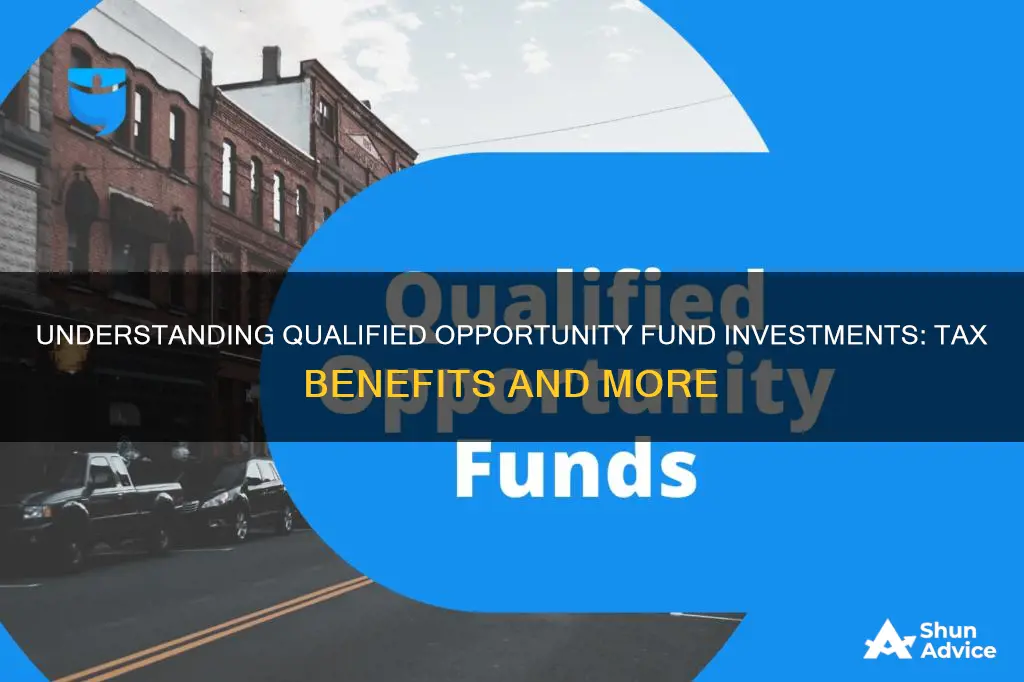
Qualified Opportunity Funds (QOFs) are investment vehicles designed to encourage business and real estate investment in economically distressed areas of the US known as opportunity zones. These funds were established by the 2017 Tax Cuts and Jobs Act to provide tax incentives for investors to put money into eligible businesses and properties within opportunity zones. By investing in a QOF, investors can defer and reduce their tax liability on capital gains. To qualify for these tax benefits, investors must reinvest their capital gains into a QOF within 180 days of the gain being recognised. The longer the investment is held in the QOF, the greater the tax benefit, with investors receiving a 10% exclusion of the deferred gain on their investment after five years, and an additional 5% exclusion after seven years. After 10 years, investors do not owe federal income taxes on the fund's appreciation.
| Characteristics | Values |
|---|---|
| Purpose | Drive business and real estate investments toward low-income or economically distressed areas of the country |
| Investor Incentive | Preferential tax treatment on capital gains |
| Eligible Gains | Capital gains or qualified 1231 gains (gains on certain types of business properties) |
| Eligible Gain Recognition | Before January 1, 2027 |
| Eligible Transactions | Cannot be generated from transactions with a related person |
| Investor Type | Accredited investor (having earned income of at least $200,000 in each of the past two years ($300,000 with a spouse) and net worth, alone or with a spouse, of at least $1 million in investable assets) |
| Investment Vehicle | REIT or partnership |
| Investment Objective | Investing in opportunity zone assets |
| Minimum Asset Investment | 90% of assets in qualified opportunity zone properties and businesses |
| Tax Form | Form 8996 |
| Tax Deferral | Until December 31, 2026, or the date the investment is sold or exchanged, whichever is earlier |
| Tax Basis Step-up | 10% after five years, 15% after seven years |
| Tax Exclusion | No federal income taxes on fund's appreciation after 10 years |
What You'll Learn
- Investors can defer taxes on capital gains by reinvesting them into qualified opportunity funds
- Opportunity funds invest in real estate or business development in economically distressed areas
- Opportunity funds arose from the creation of opportunity zones as part of the 2017 Tax Cuts and Jobs Act
- To qualify, a fund must invest at least 90% of its assets in designated opportunity zones
- Investors may need to be accredited and meet certain deadlines to qualify for tax advantages

Investors can defer taxes on capital gains by reinvesting them into qualified opportunity funds
Qualified Opportunity Funds (QOFs) are investment vehicles designed to invest in real estate or business development in economically distressed areas known as "opportunity zones". These zones are designated by the state and certified by the US Treasury Secretary via the Internal Revenue Service (IRS).
Investors can defer taxes on capital gains by reinvesting them into QOFs. Taxes can be deferred until either the day the QOF investment is sold or exchanged, or until December 31, 2026, whichever comes first. This is a temporary deferral, and the basis in the QOF investment becomes zero when the election to defer the gain is made. The basis then increases the longer the investment is held. If the investment is held for at least five years, the basis will increase by 10% of the deferred gain. If the investment is held for at least seven years, the basis will increase by an additional 5%.
For example, if an investor sells a business for $10 million, resulting in a $10 million capital gain, they can invest the entire amount in a QOF within 180 days. None of the sale proceeds would be taxable in the year of sale. Assuming a conservative rate of return on the QOF investment, this could provide a significant return to the investor over the length of the investment. After five years, the investor would be given a $1 million basis in the fund (10% of the original capital gain deferred). After seven years, they would be given another $500,000 of basis in the fund (5% of the original capital gain deferred). If the investor then sold the $10 million investment, they would pay tax on only $8.5 million of the gain.
It is important to note that the tax cannot be deferred indefinitely and that specific rules and regulations for investment in, and taxation of, QOFs may be subject to change.
The S&P Fund: A Guide to Investing Wisely
You may want to see also

Opportunity funds invest in real estate or business development in economically distressed areas
An opportunity fund is an investment vehicle designed to invest in real estate or business development in areas known as "opportunity zones". These zones are particular geographic areas that have been designated as economically distressed.
Opportunity funds arose out of the creation of opportunity zones as part of the 2017 Tax Cuts and Jobs Act (TCJA). They are intended to encourage investment in underfunded, low-income, and distressed communities. For a community to be classified as an opportunity zone, it must be designated by the state and subsequently certified by the secretary of the U.S. Treasury, via the Internal Revenue Service (IRS).
Opportunity funds must make "substantial improvements" to the properties they invest in. The TCJA defines substantial improvements as investments in the property that are equal to the original value paid by the fund. These must be made within 30 months. For example, if a property is purchased for $700,000, then the opportunity fund has a 30-month window to make at least $700,000 worth of improvements.
Certain types of businesses cannot be included in opportunity funds, even if they reside within opportunity zones. These include racetracks, gambling facilities, golf courses, country clubs, massage parlors, hot tub facilities, suntan facilities, and liquor stores.
Investors can defer their tax payments on prior investment gains if those gains are then invested in a qualified opportunity fund within 180 days after the sale. Taxes are then deferred to either the day when the opportunity fund investment is sold or exchanged, or December 31, 2026—whichever comes first.
The longer a participant holds their qualified opportunity fund investment, the smaller their tax burden may be. If held for longer than five years, then investors receive a 10% exclusion of the deferred gain on their investment. If an investor holds for more than seven years, then they receive a 15% exclusion. After 10 years, the investor does not owe federal income taxes on the fund's appreciation by the date of the sale.
Mid-Cap Funds: Smart Investment Timing for Optimal Returns
You may want to see also

Opportunity funds arose from the creation of opportunity zones as part of the 2017 Tax Cuts and Jobs Act
To qualify for these tax benefits, investors cannot invest their capital gains directly into an opportunity zone. Instead, all opportunity zone investments must pass through a qualified opportunity fund. A qualified opportunity fund is an investment vehicle structured as a REIT or partnership with the specific objective of investing in opportunity zone assets. The fund must hold and invest at least 90% of its assets in qualified opportunity zone properties and businesses.
To become a qualified opportunity fund, a taxpayer must file Form 8996 and submit it with their federal income tax return. This form certifies individuals, partnerships or corporations as organisations for investing in qualified opportunity zones.
Opportunity zones are designated by the state and subsequently certified by the secretary of the U.S. Treasury, via the Internal Revenue Service (IRS). Zones have been established in all 50 states, Washington, D.C., and U.S. territories.
The creation of opportunity funds and zones has been intended to propel economic growth through job creation, business activity and expanded housing options. However, the effectiveness of this strategy is debated. While the White House Council of Economic Advisors assessed that the funds raised by the end of 2019 could reduce poverty in opportunity zones by 11%, a 2020 study by the Urban Institute found that the capital has often benefitted real estate developers rather than the areas of greatest need.
Understanding Investment Fund Yields: A Comprehensive Guide
You may want to see also

To qualify, a fund must invest at least 90% of its assets in designated opportunity zones
To qualify as a "Qualified Opportunity Fund", an investment fund must meet certain criteria. One of the most important requirements is that the fund must invest at least 90% of its assets in designated "Opportunity Zones". These Opportunity Zones are specific geographic areas that have been identified as economically distressed or low-income communities. The aim of this program is to stimulate economic growth and create jobs in these underserved areas.
To become a Qualified Opportunity Fund, an investment fund created by a corporation or partnership must file IRS Form 8996 with their federal income tax return. This form certifies the fund as an organisation eligible to invest in Opportunity Zones. The fund must then hold at least 90% of its assets in Opportunity Zone properties or businesses. These assets can include stocks, partnership interests, or business property.
It's important to note that Opportunity Zones are designated by the state and certified by the US Treasury Department. They exist in all 50 US states, Washington, D.C., and US territories. Investors interested in participating in Qualified Opportunity Funds should consult with investment and tax professionals to ensure they meet all the necessary requirements.
Retirement Funds: Real Estate Investment Strategies for Secure Future
You may want to see also

Investors may need to be accredited and meet certain deadlines to qualify for tax advantages
To qualify for tax advantages, investors need to meet specific criteria and deadlines when investing in a Qualified Opportunity Fund (QOF). Firstly, investors must meet the deadlines for reinvesting eligible gains and filing the necessary forms. They have 180 days from the date of realising eligible gains, such as capital gains or qualified 1231 gains, to reinvest them into a QOF. This 180-day period also applies to taxpayers receiving reported capital gains from flow-through entities like partnerships or S-corporations. To elect tax deferral, investors must complete Form 8949 and file it with their tax return. Form 8997, the Initial and Annual Statement of QOF Investments, must also be submitted annually.
Secondly, investors may need to be accredited, depending on the specific QOF. Becoming an accredited investor typically requires an individual to have earned income of at least $200,000 in each of the previous two years ($300,000 with a spouse) and a net worth of at least $1 million in investable assets.
By meeting these requirements and deadlines, investors can take advantage of the tax benefits offered by QOFs, including tax deferral, step-up in tax basis, and potential tax exclusion on appreciation.
A Guide to Investing IRA Funds in Taxable Accounts
You may want to see also
Frequently asked questions
A qualified opportunity fund investment is a vehicle designed to invest in real estate or business development in areas known as "opportunity zones". These are geographic areas that have been designated as economically distressed and are therefore subject to different economic regulations.
Qualified opportunity fund investments offer tax advantages and benefits to investors, such as the ability to defer and potentially reduce taxes on capital gains.
To qualify as a qualified opportunity fund investment, the fund must invest at least 90% of its assets in designated opportunity zones and make “substantial improvements” to the properties it invests in.
A qualified opportunity fund can be established by filing Form 8996 with the Internal Revenue Service (IRS) and submitting it with your federal income tax return.







